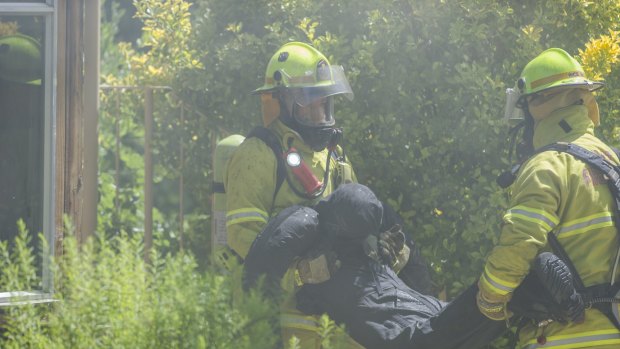- National
- ACT
This was published 9 years ago
Inside with the fire investigators as patterns, clues reveal all
After torching a Farrer house on Thursday, fire investigators returned on Friday to see whether they could pinpoint the cause. Tom Heath reports.
By Tom Heath
After torching a Farrer house on Thursday, fire investigators returned on Friday to see whether they could pinpoint the cause.
On entering the scorched living room of the house, senior fire investigator Anthony Walker looks first for the origin point.

Firefighters carry a dummy out of the house.Credit: Jamila Toderas
"We look for what is the most destroyed thing in the room, which in this case is pretty obvious," he said, indicating the charred frame of a lounge chair. "It's not rocket science, what we do. But we can start taking bits and pieces of information and take it from there."
ACT Fire and Rescue set three fires in the former government house on Thursday, with their first task to put it out. The second training session is to find the cause of the three fires.
In the living room fire, the damage to the chair is incriminating but investigators need to look beyond that for other clues. The clue that drew Mr Walker's attention is a "V pattern"; charring that branches upwards from the remains of the chair.
"The bottom of a V pattern is generally the origin of a fire," he said. "The gases rise in an outward motion, drawing a line of destruction that points back to the fire."
The other sign the chair was the origin point was the severe charring on the inner frame, he said, referring to it as "alligatoring", given the alligator pattern.
"Look, we're not really clever with our names," he said. "But alligatoring is an indication of long exposure to heat and it starts to tell us where the fire was burning for the longest."
A surprising clue to origin comes from light bulbs.
"Light bulbs don't often shatter [in fires]," Mr Walker said. "A light bulb will tend to bend towards heat and, assuming it doesn't fall out of the ceiling, it will actually be pointed towards the fire."
With the origin determined, the next step is to assess cause.
The obvious culprit is a portable heater leaning against the chair, with a V pattern burn running along it. But Mr Walker warned that before reaching that conclusion investigators must consider other things - namely: the firefighters first on the scene.
"Was that heater always there, or has a firefighter kicked it out of the way during the rescue," he said. "We always need to talk to our people to figure out what's going on.
"As a fire investigator, I'd love for the firefighters to just come in and look after things for me but they're here to do a job and that job is to put the fire out. However, talking to them and asking 'what did you move?' can really help us out."
In this case, the heater wasn't moved by firefighters and is determined as the cause. But if there were signs such as multiple origin points or windows broken by hand, it would have been time to involve the police, Mr Walker said.
"ACT Fire and Rescue don't investigate suspicious fires," he said. "Once it becomes suspicious we'd be straight on the phone to AFP and it's not our problem any more.
"But we have a memorandum of understanding, which says we will still hang around and help the police out."
Mr Walker said exercises to train firefighters to become investigators were important as the experience gained as a firefighter was invaluable to the investigation.
"There's a science to it, a lot of it is an art as well which you get from seeing lots of fires," he said. "That's why every fire service in the world has firefighters [investigating].
"The stuff we see all the time from a firefighting perspective helps but no one thing will ever tell us what [happened] so we arm these guys to look for patterns. Talk to the firefighters, talk to the owners, and just collect as much evidence as you can to come up with an idea of what happened."